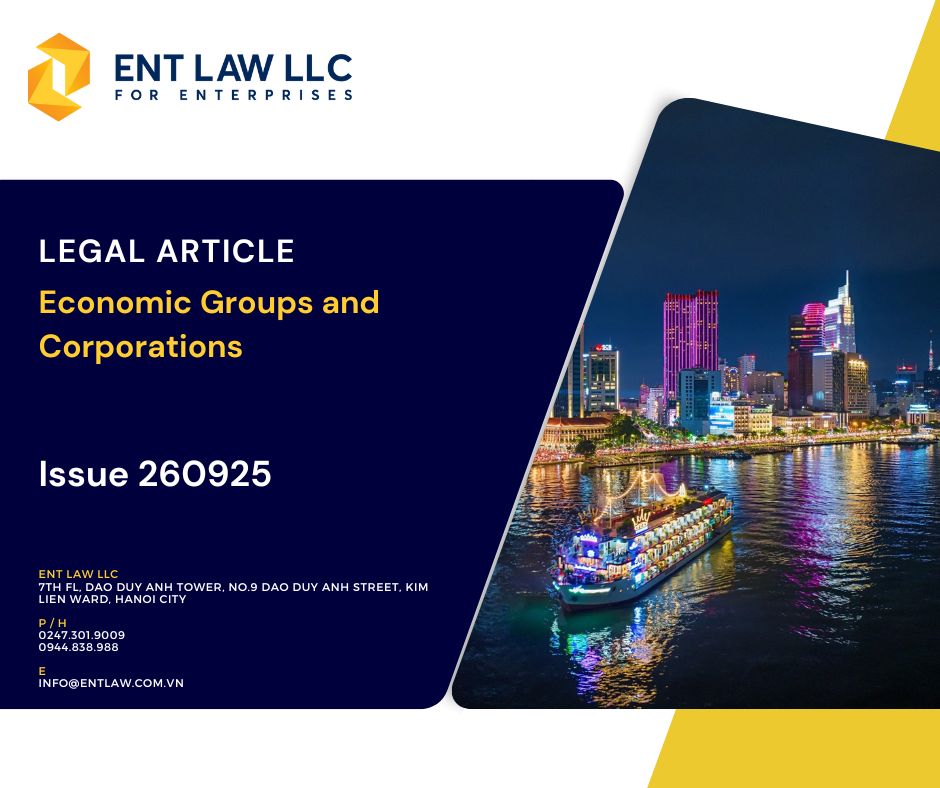Dear Valued Clients,
In the course of developing a market economy and integrating internationally, Vietnam has witnessed the emergence and growth of many large-scale business conglomerates, the most common of which are economic groups (“EG”) and corporations (“Corp.”). The formation of these models aims to concentrate resources, expand scale, enhance competitiveness, and at the same time create conditions for enterprises to participate more deeply in domestic and global value chains.
This article provides an overview of the key legal issues relating to EGs and Corps.
I. Definition
According to Article 194 of the Law on Enterprises 2020 (as amended and supplemented in 2022 and 2025) (“LOE”), EGs and Corp are groups of companies that are related to each other through shareholding, capital contribution, or other forms of association.
II. Characteristics
EG and Corp share the following common characteristics:
- They are not a type of enterprise;
- They do not have legal person status and are not subject to incorporation registration;
- They consist of a parent company, subsidiaries, and other member companies, managed through capital ownership and management relations. The parent company and subsidiaries have legal person status and enjoy the rights and obligations of independent enterprises under the law.
III. The current models
3.1. State-owned EG and Corp
State-owned EG and Corp: are a group of companies formed on the basis of a group of companies, in which the parent company is an enterprise wholly owned by the State or in which the State retains controlling rights in accordance with the law. According to Decree No. 69/2014/ND-CP, the establishment, reorganization, or dissolution of state-owned EGs and Corp falls under the authority of the Prime Minister, based on a proposal prepared and submitted by the representative agency of the State owner.
Example: The Vietnam National Oil and Gas Group (PVN) was established under Decision No. 98/2006/QD-TTg dated August 29, 2006 of the Prime Minister; the Vietnam Electricity Group (EVN) was established under Decision No. 562/QD-TTg dated October 10, 1994 of the Prime Minister.
3.2. Private EG and Corp
- Private EG and Corp are groups of companies formed from private capital, developed based on the parent company–subsidiary model or through controlling shareholding.
- Currently, Vietnamese law does not provide specific regulations for private EGs and Corp. Their operations are mainly governed by the Law on Enterprises 2020 (provisions on groups of companies and parent–subsidiary companies) together with specialized laws (such as the Law on Securities 2019, the Law on Competition 2018, etc.).
Example: Vingroup, Masan Group, Sungroup, Vietjet Air.
IV. The Relationship between Parent Company and Subsidiary
- According to Article 195 of the Law on Enterprises 2020, a parent–subsidiary relationship is established when a company is capable of controlling another company. Specifically, a company is considered a parent company if it falls into one of the following cases:
+ It owns more than 50% of the charter capital or the total number of voting shares of another company;
+ It has the right, directly or indirectly, to decide on the appointment of the majority or all members of the Board of Directors, the Director, or the General Director of another company;
+ It has the right to decide on the amendment or supplementation of the Charter of another company.
- The parent–subsidiary relationship is governed by the following legal principles:
+ The parent company and subsidiaries have independent legal person status, maintain independent accounting, and are independently liable with their own assets, except in certain cases of violations where the parent company unlawfully interferes with the subsidiary;
+ A subsidiary is not allowed to contribute capital to or purchase shares of its parent company; subsidiaries of the same parent company are not allowed to contribute capital to or purchase shares in order to hold cross-ownership with one another;
+ The parent company has the obligation to prepare consolidated financial statements that truthfully reflect the financial situation of the entire group of companies in accordance with accounting standards.
As usual, we hope that you find this article useful and look forward to working with you in the near future.
Sincerely,

 Tiếng Việt
Tiếng Việt


Issue 021225 – Important points to note in the execution of the labor contract
Dear Valued Clients, The labor contract is the main legal basis regulating the rights and obligations between the...
Dec
Issue 021225 – General Provisions on Job-Loss Allowance
Dear Valued Clients, Job loss allowance is one of the key obligations imposed on employers to safeguard employees’...
Dec
Issue 021225 – Workplace Dialogue Organization
Dear Valued Clients, Workplace dialogue is one of the key mechanisms for strengthening the connection between employees and...
Dec
Issue 021225 – Vocational Training and Internship for Employment with Employers
Dear Valued Clients, Vocational training and internship for employment with an employer (“Employer”) is the process by which...
Dec